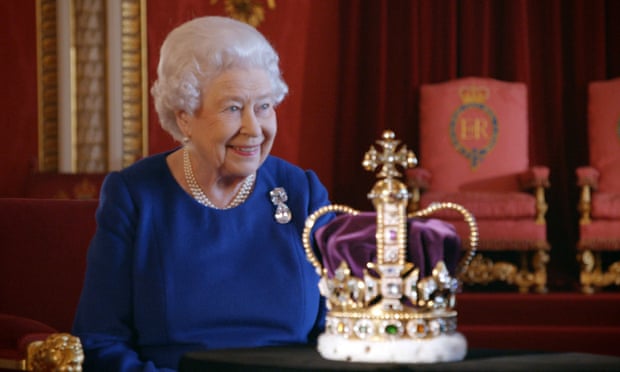https://i.guim.co.uk/img/media/8c5392e2a01f6a34c7efb99f12fcbf9e70c37fef/106_99_1710_1026/master/1710.jpg?w=620&q=55&auto=format&usm=12&fit=max&s=18c2ba1cf6b78130a3f9a5f43c2f048f

In 1930, MGM could revel in its success. Anna Christie was released to the accompaniment of the blazing promise “Garbo talks!” to mark the first time the silent film star had given utterance on camera. I suspect the BBC’s publicity department collectively ruptured several vital organs as they strained not to do the same with their coup. After 22 years of negotiations, our notoriously camera-hating sovereign agreed to talk on camera in The Coronation, a documentary to mark 65 years since she ascended the throne. “Queenie speaks!” was surely the strapline everyone wanted. Closely followed by “Farkin’ ’ell!”
The Coronation was presented by former herald and “coronation expert” Alastair Bruce, because this is 2018 and this is England and no one had the balls to let Alan Bennett do it, but do you know what? It could have been a lot worse.
The tone was only ever momentarily reverential, and when it slipped into that squishy territory it was usually the Queen herself who yanked it back out on to dry land.

Watching Her Majesty’s personal footage of the 1953 ceremony’s aftermath, as the young Prince Charles and Princess Anne played hide-and-seek underneath her train, Bruce murmured “Such fun for the children.”
“Not what they were meant to do,” the mother-monarch replied tartly.
Later, when Bruce asked the white-gloved crown jeweller (one of the three people who is allowed to touch it; this is 2018, this is England) “if the crown can be brought a little closer to the Queen”, she moved it herself.
“This is what I do when I wear it!”, our Sovereign grinned delightedly, the spider at the centre of a webby mass of protocol and etiquette, across whose sticky strands only she can stride safely.
When Her Majesty was not on screen, obsequiousness was kept at bay by concentrating on the origins of the regalia and the ceremony, wisely treating them all as embodiments and vectors of history rather than mere accretions of pageantry.
It won’t turn you from republican to ardent monarchist to know that although the St Edward’s Crown was created in 1661 for Charles II, the makers strove to replicate Edward the Confessor’s. They did that to assure a people riven by civil war that there would be a return to medieval certainties, but it is surely fairer to know what it is you are embracing or dismissing.
Contemporary footage showed the breathtaking scale of the preparations and the Duke of Norfolk’s talent for organisation down to the last detail (the maids of honour had phials of smelling salts tucked behind their glove buttons in case they fainted). Though I guess it comes slightly easier when overseeing extraordinary state occasions has been your family’s raison d’etre for five centuries.
But it was Elizabeth Garbo we’d come to see, and for once, a royal documentary didn’t cheat its punters by making an ounce of access fill a hogshead of primetime. She was there. She spoke. She let the mask slip by a reasonable degree. And it matters not where you stand on the republican-monarchist spectrum; it was fascinating to watch the public persona be briefly set aside.
I personally feel that my entire licence fee has been well spent just to secure the moment when she flicked the St Edward’s Crown (2kg of gold frame encrusted with 444 precious stones) with a casual finger to appraise its solidity.
“Yes, weighs a ton,” she remembered cheerfully (Queenie smiles! Four times in the hour, by my reckoning). She hasn’t seen or worn it since that day in 1953. She wears the Imperial State Crown to things like the state opening of parliament. It’s her everyday crown. When the dress code says “smart casual”, that’s the one she – as her father did before her – pops on.
“Fortunately,” she notes, “my father and I have the same sort of shaped head.” You can’t look down in it, though, she added. “Or your neck would break. And it would fall off.”
“Pearls,” she said, while joggling in her hand a quartet that once belonged to Mary, Queen of Scots, then Elizabeth I, and now dangle from the state crown, “are sort of living things. They need warming up and these have just been hanging here. Quite sad, really.”
In the BBC’s capable hands, this was a warming programme for a sovereign whose refusal to “engage” has dulled her lustre to modern eyes. But there was a melancholy at the heart of it. At 91, this will likely be the first and last time we glimpse the ‘real’ monarch.
If The Coronation was a fine display of living history, it was also, somewhere beneath its surface, a living elegy. She will become, sooner rather than later, one of the memories enshrined in the ancient regalia. And we will remember this warmth, and it will all be quite sad, really.
guardian.co.uk © Guardian News & Media Limited 2010
Published via the Guardian News Feed plugin for WordPress.
The Coronation review – Queen shines in a surprisingly fun royal couphttps://goo.gl/WgbFrP











0 comments:
Post a Comment